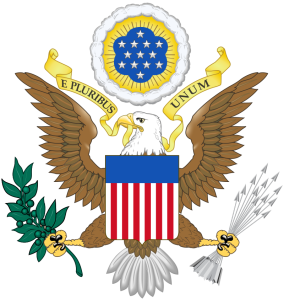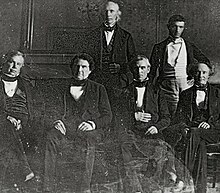Cabinet of the United States – Federal law – History
Những Nội Dung Chính Bài Viết
- Cabinet of the United States – Federal law – History
- History[edit]
- Federal law[edit]
- Confirmation process[edit]
- Current Cabinet and Cabinet-rank officials[edit]
- Former executive and Cabinet-level departments[edit]
- Renamed heads of the executive departments[edit]
- Positions intermittently elevated to Cabinet-rank[edit]
- Proposed Cabinet departments[edit]
- See also[edit]
- References[edit]
- Further reading[edit]
Cabinet of the United States – Federal law – History
The Cabinet of the United States is a group of high-ranking government officials who advise the President of the United States. It is not established by federal law but is instead a tradition that has developed over the course of American history. Here is a brief overview of the history and role of the U.S. Cabinet:
History:
- The U.S. Cabinet traces its origins to the early days of the American republic. It was not explicitly mentioned in the U.S. Constitution but was established through precedent and custom.
- President George Washington is often credited with creating the first Cabinet. In 1789, he appointed four key advisers, who became known as the “Heads of Departments.” These initial departments were the Department of State, the Department of the Treasury, the Department of War, and the Office of the Attorney General (now the Department of Justice).
- The early Cabinet members were tasked with providing the President with expert advice on matters related to their respective departments.
- Over time, the number of Cabinet departments expanded to include positions such as the Secretary of Agriculture, the Secretary of Commerce, and the Secretary of Labor, among others.
- The Cabinet has evolved and changed in response to the needs of the country. New departments have been created, and the responsibilities of existing ones have shifted.
Role and Function:
- The U.S. Cabinet serves as a group of the President’s chief advisers. Cabinet members are nominated by the President and confirmed by the Senate.
- The primary function of the Cabinet is to provide the President with expertise and advice on a wide range of issues, including foreign policy, national security, economic matters, and domestic policy.
- Cabinet members oversee and manage their respective federal departments, agencies, and programs.
- While the Cabinet advises the President, it does not make policy decisions or set government priorities. The President ultimately makes these decisions.
Current Cabinet Departments (As of September 2021):
- Department of State
- Department of the Treasury
- Department of Defense
- Department of Justice
- Department of the Interior
- Department of Agriculture
- Department of Commerce
- Department of Labor
- Department of Health and Human Services
- Department of Housing and Urban Development
- Department of Transportation
- Department of Energy
- Department of Education
- Department of Veterans Affairs
- Department of Homeland Security
In addition to the 15 Cabinet departments listed above, the Cabinet may also include other key officials, such as the Vice President and the White House Chief of Staff.
While the U.S. Cabinet has no specific legal foundation in federal law, it plays a critical role in the functioning of the U.S. government, providing expertise and policy advice to the President on matters of national importance.

Cabinet of the United States – Federal law – History
Advisory body toàn thân to the president
The Cabinet of the United States is a body consisting of the vice president of the United States and the heads of the executive branch’s departments in the federal government of the United States. It is the principal official advisory body to the president of the United States. The president chairs the meetings but is not formally a member of the Cabinet. The heads of departments, appointed by the president and confirmed by the Senate, are members of the Cabinet, and acting department heads also participate in Cabinet meetings whether or not they have been officially nominated for Senate confirmation. The president may designate heads of other agencies and non-Senate-confirmed members of the Executive Office of the President as members of the Cabinet.
The Cabinet does not have any collective executive powers or functions of its own, and no votes need to be taken. There are 24 members (25 including the vice president): 15 department heads and nine Cabinet-level members, all of whom, except two, require Senate confirmation. The Cabinet meets with the president in a room adjacent to the Oval Office. The members sit in the order in which their respective department was created, with the earliest being closest to the president and the newest farthest away.[1]
Bạn đang đọc: Cabinet of the United States – Wikipedia
The members of the Cabinet serve at the pleasure of the president, who can dismiss them at any time without the approval of the Senate, as affirmed by the Supreme Court of the United States in Myers v. United States (1926) or downgrade their Cabinet membership status. Often it is legally possible for a Cabinet member to exercise certain powers over his or her own department against the president’s wishes, but in practice this is highly unusual due to the threat of dismissal. The president also has the authority to organize the Cabinet, such as instituting committees. Like all federal public officials, Cabinet members are also subject to impeachment by the House of Representatives and trial in the Senate for “treason, bribery, or other high crimes and misdemeanors”.
The Constitution of the United States does not explicitly establish a Cabinet. The Cabinet’s role, inferred from the language of the Opinion Clause ( Article II, Section 2, Clause 1 ) of the Constitution is to provide advice to the president. Additionally, the Twenty-fifth Amendment authorizes the vice president, together with a majority of the heads of the executive departments, to declare the president ” unable to discharge the powers and duties of his office “. The heads of the executive departments are — if eligible — in the presidential line of succession .
History[edit]
 James K. Polk and his Cabinet in 1846: the first Cabinet to be photographed.
James K. Polk and his Cabinet in 1846: the first Cabinet to be photographed.
The tradition of the Cabinet arose out of the debates at the 1787 Constitutional Convention regarding whether the president would exercise executive authority solely or collaboratively with a cabinet of ministers or a privy council. As a result of the debates, the Constitution ( Article II, Section 1, Clause 1 ) vests ” all executive power ” in the president singly, and authorizes — but does not compel — the president ( Article II, Section 2, Clause 1 ) to ” require the Opinion, in writing, of the principal Officer in each of the executive Departments, upon any Subject relating to the Duties of their respective Offices “. [ 2 ] [ 3 ] The Constitution does not specify what the executive departments will be, how many there will be, or what their duties will be .George Washington, the first president of the United States, organized his principal officers into a Cabinet, and it has been part of the executive branch structure ever since. Washington’s Cabinet consisted of five members : himself, Secretary of State Thomas Jefferson, Secretary of the Treasury Alexander Hamilton, Secretary of War Henry Knox and Attorney General Edmund Randolph. Vice President John Adams was not included in Washington’s Cabinet because the position was initially regarded as a legislative officer ( president of the Senate ). [ 4 ] Furthermore, until there was a vacancy in the presidency ( which did not occur until the death of William Henry Harrison in 1841 ) it was not certain that a vice president would be allowed to serve as president for the duration of the original term as opposed to merely acting as president until new elections could be held. It was not until the 20 th century that vice presidents were regularly included as members of the Cabinet and came to be regarded primarily as a thành viên of the executive branch .Presidents have used Cabinet meetings of selected principal officers but to widely differing extents and for different purposes. During President Abraham Lincoln ‘ s administration, Secretary of State William H. Seward advocated the use of a parliamentary-style Cabinet government. However, Lincoln rebuffed Seward. While a professor Woodrow Wilson also advocated a parliamentary-style Cabinet, but after becoming president did not implement it in his administration. In recent administrations, Cabinets have grown to include key White House staff in addition to department and various agency heads. President Ronald Reagan formed seven sub-cabinet councils to review many policy issues, and subsequent presidents have followed that practice. [ 3 ]Federal law[edit]
In 3 U.S.C. § 302 with regard to delegation of authority by the president, it is provided that ” nothing herein shall be deemed to require express authorization in any case in which such an official would be presumed in law to have acted by authority or direction of the president. ” This pertains directly to the heads of the executive departments as each of their offices is created and specified by statutory law ( hence the presumption ) and thus gives them the authority to act for the president within their areas of responsibility without any specific delegation .Under 5 U.S.C. § 3110 ( also known as the 1967 Federal Anti-Nepotism statute ), federal officials are prohibited from appointing their immediate family members to certain governmental positions, including those in the Cabinet. [ 5 ]Under the Federal Vacancies Reform Act of 1998, an administration may appoint acting heads of department from employees of the relevant department. Thes e may be existing high-level career employees, from political appointees of the outgoing administration ( for new administrations ), or sometimes lower-level appointees of the administration. [ 6 ]
Confirmation process[edit]
A map showing the historical makeup of the Cabinet of the United States by year.
The heads of the executive departments and all other federal agency heads are nominated by the president and then presented to the Senate for confirmation or rejection by a simple majority ( although before the use of the ” nuclear option ” during the 113 th United States Congress, they could have been blocked by filibuster, requiring cloture to be invoked by 3 ⁄ 5 supermajority to further consideration ). If approved, they receive their commission scroll, are sworn in, and begin their duties. When the Senate is not in session, the president can appoint acting heads of the executive departments, and do so at the beginning of their term .An elected vice president does not require Senate confirmation, nor does the White House chief of staff, which is an appointed staff position of the Executive Office of the President .Salary[edit]
The heads of the executive departments and most other senior federal officers at cabinet or sub-cabinet level receive their salary under a fixed five-level pay plan known as the Executive Schedule, which is codified in Title 5 of the United States Code. Twenty-one positions, including the heads of the executive departments and others, receiving Level I pay are listed in 5 U.S.C. § 5312, and those forty-six positions on Level II pay ( including the number two positions of the executive departments ) are listed in 5 U.S.C. § 5313. As of January 2023, the Level I annual pay was set at $ 235,600 .
The annual salary of the vice president is $235,300.[7] The salary level was set by the Government Salary Reform Act of 1989, which provides an automatic cost of living adjustment for federal employees. The vice president receives the same pension as other members of Congress based on their ex officio position as the president of the Senate.[8]
Current Cabinet and Cabinet-rank officials[edit]
The individuals listed below were nominated by President Joe Biden to form his Cabinet and were confirmed by the United States Senate on the date noted or are serving as acting department heads by his request, pending the confirmation of his nominees.
Xem thêm: American Airlines – Wikipedia tiếng Việt
Vice president and the heads of the executive departments[edit]
The Cabinet permanently includes the vice president and the heads of 15 executive departments, listed here according to their order of succession to the presidency. The speaker of the House and the president pro tempore of the Senate follow the vice president and precede the secretary of state in the order of succession, but both are in the legislative branch and are not part of the Cabinet.
Cabinet-level officials[edit]
The president may designate additional positions to be members of the Cabinet, which can vary under each president. They are not in the line of succession and are not necessarily officers of the United States. [ 9 ]
- ^Elevated to Cabinet on July 21, 2023
Former executive and Cabinet-level departments[edit]
Renamed heads of the executive departments[edit]
Positions intermittently elevated to Cabinet-rank[edit]
Proposed Cabinet departments[edit]
See also[edit]
References[edit]
Further reading[edit]
- Bennett, Anthony. The American President’s Cabinet. Houndmills, Basingstoke, Hampshire: Macmillan, 1996. ISBN 0-333-60691-4. A study of the U.S. Cabinet from Kennedy to Clinton.
- Grossman, Mark. Encyclopedia of the United States Cabinet (Santa Barbara, California: ABC-CLIO; three volumes, 2000; reprint, New York: Greyhouse Publishing; two volumes, 2010). A history of the United States and Confederate States Cabinets, their secretaries, and their departments.
- Rudalevige, Andrew. “The President and the Cabinet”, in Michael Nelson, ed., The Presidency and the Political System, 8th ed. (Washington, D.C.: CQ Press, 2006).
Xem thêm: American Airlines – Wikipedia tiếng Việt
Source: https://suadieuhoa.edu.vn
Category : American















